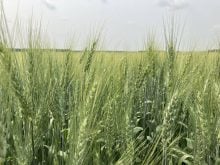Growers who haven’t yet assessed their winter wheat crop should get out in the field in the next few days.Mark Akins, winter wheat specialist with Ducks Unlimited Canada in southern Saskatchewan, said the final decision on reseeding must be made by the end of the month so that the spring replacement crop has a chance to mature.”The good news is that very few hard decisions have to be made this year,” he said last week.”The vast majority of the crops have come through the winter very well.”Akins said there was concern last fall after late seeding. Growers want crops to reach the three leaf stage with a tiller or two before winter.”The majority of growers did not attain that leaf stage in the fall,” he said.But excellent snow cover, in the form of a continuous layer, kept most crops in good condition. A 10-centi-metre layer of snow provides enough insulation.Then, the cool, moist weather this spring provided optimal early growing conditions.Generally, winter wheat should be assessed between May 15 and May 25 to give the crop enough time to recover from winter and growers time to reseed by June 1, if necessary.Akins said producers are looking for a crop that is lush and green. It won’t be tall, but it should be at the five or six leaf stage and tillering.Patchy crops aren’t necessarily a concern because the crop will fill in.”They should probably get their herbicide applications done,” Akins said. “Within two weeks, the crop will have completely covered the ground.”But patches do make the reseeding decision difficult. Thin winter wheat stands can still produce strong yields because of the crop’s ability to tiller.The general rule is that eight plants per sq. foot is the point at which a grower would consider reseeding. Saskatchewan Crop Insurance pays out an establishment benefit for less than five plants per sq. foot. The customer has the option to reseed if there are between five and seven per sq. foot.”The problem is, I never see fields with eight plants per sq. foot across a whole field,” Akins said.There can be bare patches or others with 20 to 30 plants per sq. foot, which is the optimal number.”Those areas are what’s going to make your decision difficult,” he said. “It comes down to how much open space a grower can stand.”Removing a few plants from the worst areas, placing them on a moist paper towel in a warm room and exposing them to light for at least a few hours during the day can help in the assessment.Damaged crown tissue will turn brown while healthy tissue will stay white and start to produce new roots in a few days.Research has found that 7.7 plants per sq. foot yield 47 bushels per acre, while 30.4 plants yield 60 bu. per acre.Akins said reseeding doesn’t always result in a better crop than those yields. He suggested farmers who are struggling with the decision contact crop insurance, DUC or other agrol-ogists for assistance.Meanwhile, nitrogen should have already been applied to encourage tillering and reduce competition from weeds. Akins said some farmers may choose to top dress an additional 20 to 30 pounds of nitrogen and that should be done by the end of May.According to Statistics Canada, western Canadian farmers seeded 650,000 acres to winter wheat last fall – 250,000 in Manitoba and 200,000 each in Saskatchewan and Alberta.That was down significantly from the 1.2 million in 2008. Akins said poor fall conditions have contributed to declining acreage.
Read Also

Volatile temperatures expected for this winter
DTN is forecasting a lot of temperature variability in the Canadian Prairies this winter. Precipitation should be close to average.















